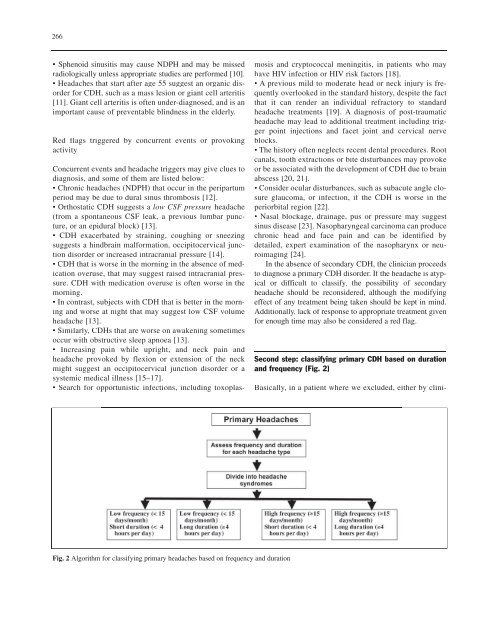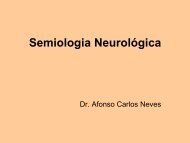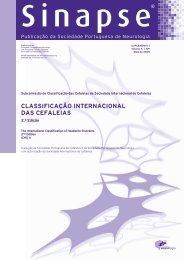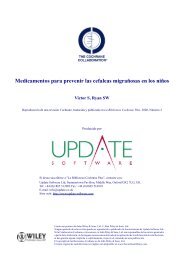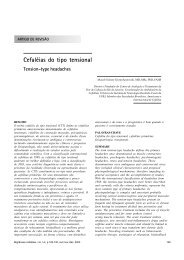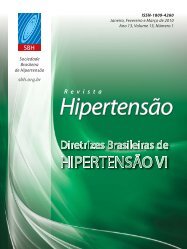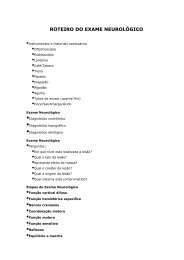The differential diagnosis of chronic daily headaches: an ... - marchioli
The differential diagnosis of chronic daily headaches: an ... - marchioli
The differential diagnosis of chronic daily headaches: an ... - marchioli
Create successful ePaper yourself
Turn your PDF publications into a flip-book with our unique Google optimized e-Paper software.
266<br />
• Sphenoid sinusitis may cause NDPH <strong>an</strong>d may be missed<br />
radiologically unless appropriate studies are performed [10].<br />
• Headaches that start after age 55 suggest <strong>an</strong> org<strong>an</strong>ic disorder<br />
for CDH, such as a mass lesion or gi<strong>an</strong>t cell arteritis<br />
[11]. Gi<strong>an</strong>t cell arteritis is <strong>of</strong>ten under-diagnosed, <strong>an</strong>d is <strong>an</strong><br />
import<strong>an</strong>t cause <strong>of</strong> preventable blindness in the elderly.<br />
Red flags triggered by concurrent events or provoking<br />
activity<br />
Concurrent events <strong>an</strong>d headache triggers may give clues to<br />
<strong>diagnosis</strong>, <strong>an</strong>d some <strong>of</strong> them are listed below:<br />
• Chronic <strong>headaches</strong> (NDPH) that occur in the peripartum<br />
period may be due to dural sinus thrombosis [12].<br />
• Orthostatic CDH suggests a low CSF pressure headache<br />
(from a spont<strong>an</strong>eous CSF leak, a previous lumbar puncture,<br />
or <strong>an</strong> epidural block) [13].<br />
• CDH exacerbated by straining, coughing or sneezing<br />
suggests a hindbrain malformation, occipitocervical junction<br />
disorder or increased intracr<strong>an</strong>ial pressure [14].<br />
• CDH that is worse in the morning in the absence <strong>of</strong> medication<br />
overuse, that may suggest raised intracr<strong>an</strong>ial pressure.<br />
CDH with medication overuse is <strong>of</strong>ten worse in the<br />
morning.<br />
• In contrast, subjects with CDH that is better in the morning<br />
<strong>an</strong>d worse at night that may suggest low CSF volume<br />
headache [13].<br />
• Similarly, CDHs that are worse on awakening sometimes<br />
occur with obstructive sleep apnoea [13].<br />
• Increasing pain while upright, <strong>an</strong>d neck pain <strong>an</strong>d<br />
headache provoked by flexion or extension <strong>of</strong> the neck<br />
might suggest <strong>an</strong> occipitocervical junction disorder or a<br />
systemic medical illness [15–17].<br />
• Search for opportunistic infections, including toxoplasmosis<br />
<strong>an</strong>d cryptococcal meningitis, in patients who may<br />
have HIV infection or HIV risk factors [18].<br />
• A previous mild to moderate head or neck injury is frequently<br />
overlooked in the st<strong>an</strong>dard history, despite the fact<br />
that it c<strong>an</strong> render <strong>an</strong> individual refractory to st<strong>an</strong>dard<br />
headache treatments [19]. A <strong>diagnosis</strong> <strong>of</strong> post-traumatic<br />
headache may lead to additional treatment including trigger<br />
point injections <strong>an</strong>d facet joint <strong>an</strong>d cervical nerve<br />
blocks.<br />
• <strong>The</strong> history <strong>of</strong>ten neglects recent dental procedures. Root<br />
c<strong>an</strong>als, tooth extractions or bite disturb<strong>an</strong>ces may provoke<br />
or be associated with the development <strong>of</strong> CDH due to brain<br />
abscess [20, 21].<br />
• Consider ocular disturb<strong>an</strong>ces, such as subacute <strong>an</strong>gle closure<br />
glaucoma, or infection, if the CDH is worse in the<br />
periorbital region [22].<br />
• Nasal blockage, drainage, pus or pressure may suggest<br />
sinus disease [23]. Nasopharyngeal carcinoma c<strong>an</strong> produce<br />
<strong>chronic</strong> head <strong>an</strong>d face pain <strong>an</strong>d c<strong>an</strong> be identified by<br />
detailed, expert examination <strong>of</strong> the nasopharynx or neuroimaging<br />
[24].<br />
In the absence <strong>of</strong> secondary CDH, the clinici<strong>an</strong> proceeds<br />
to diagnose a primary CDH disorder. If the headache is atypical<br />
or difficult to classify, the possibility <strong>of</strong> secondary<br />
headache should be reconsidered, although the modifying<br />
effect <strong>of</strong> <strong>an</strong>y treatment being taken should be kept in mind.<br />
Additionally, lack <strong>of</strong> response to appropriate treatment given<br />
for enough time may also be considered a red flag.<br />
Second step: classifying primary CDH based on duration<br />
<strong>an</strong>d frequency (Fig. 2)<br />
Basically, in a patient where we excluded, either by clini-<br />
Fig. 2 Algorithm for classifying primary <strong>headaches</strong> based on frequency <strong>an</strong>d duration


